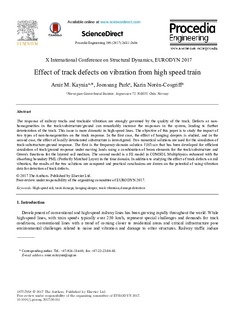Effect of track defects on vibration from high speed train
Peer reviewed, Journal article
Published version
Permanent lenke
http://hdl.handle.net/11250/2456543Utgivelsesdato
2017Metadata
Vis full innførselSamlinger
- NGI articles [1026]
Sammendrag
The response of railway tracks and trackside vibration are strongly governed by the quality of the track. Defects or non-homogeneities in the track/substructure/ground can remarkably increase the responses in the system, leading to further deterioration of the track. This issue is more dramatic in high-speed lines. The objective of this paper is to study the impact of two types of non-homogeneities on the track response. In the first case, the effect of hanging sleepers is studied, and in the second case, the effect of locally deteriorated substructure is investigated. Two numerical solutions are used for the simulation of track-substructure-ground response. The first is the frequency-domain solution VibTrain that has been developed for efficient simulation of track/ground response under moving loads using a combination of beam elements for the track/substructure and Green’s functions for the layered soil medium. The second model is a FE model in COMSOL Multiphysics enhanced with the absorbing boundary PML (Perfectly Matched Layer) in the time domain. In addition to studying the effect of track defects on rail vibration, the results of the two solutions are compared and practical conclusions are drawn on the potential of using vibration data for detection of track defects.
